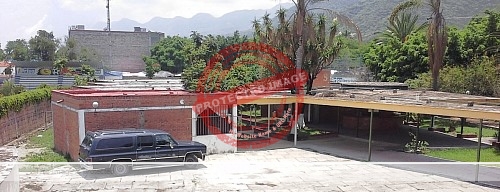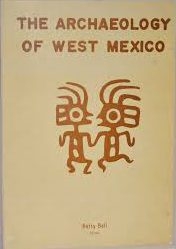In the 1970s, Ajijic was the center, for a few years at least, of a higher education organization that specialized in archaeology, anthropology and history.
An Ajijic couple – geographer Dr. William W. Winnie Jr. and his wife, archaeologist Dr. Betty Bell – were the driving force behind the creation in 1971 of the Sociedad de Estudios Avanzados del Occidente de Mexico (West Mexican Society for Advanced Study). In its formal constitution as a Mexican civil association (A.C.), the society listed the following aims:
- 1. To promote research on West Mexico, principally in the following fields: (a) anthropology and related fields; (b) history; (c) the urbanization process;
- 2. To facilitate study by Mexican and foreign institutions or individuals interested in the fields in which the Society is active, and to promote collaboration among them.
- 3. To facilitate post-graduate study by people from this region in universities outside the country, and vice versa.
- 4. To serve as liaison and a means of coordination between institutions and researchers working in this region, and those elsewhere who have the same objectives.
- 5. To organize and operate an information center relative to the proposed subject matter and region.
- 6. To create a center for advanced study of West Mexico, with the participation of national and foreign institutions interested in the professional fields proposed by the Society.
Its physical location in Ajijic, grandly titled The West Mexican Center for Advanced Study, was provided by the Government of the State of Jalisco in a building that had formerly been the Escuela Regional de Artesanias (Regional School for Handicrafts).
The society planned to offer courses for the benefit of the local community as well as to arrange a fellowship program and orientation for graduate study in U.S. institutions; a publication program; library; exhibits; field courses; seminars and symposia; anthropological research; historical research; and research on the urbanization process.
The Honorary President of the West Mexican Society for Advanced Study was the Hon. Lic. Alberto Orozco Romero, the then Governor of the State of Jalisco. Board members included Dr. Ramon Naranjo Jimenez, Arq. Luis Ortiz Macedo, Lic. Jose Parres Arias, Ing. Federico Solorzano Barreto and Arq. Daniel Vazquez Aguilar. The society’s General Executive Coordinator was Dr. William W. Winnie Jr.
Signed-up members of the society included some very distinguished archaeologists, anthropologists and historians, including Ignacio Bernal, Donald D. Brand, Beatriz Braniff, Pedro Carrasco, Michael D. Coe, George M. Foster, Robert E. Greengo, Wigberto Jiménez Moreno, J. Charles Kelley, José Luis Lorenzo, Eduardo Matos Moctezuma, H. B. Nicholson, Otto Schöndube, Stuart D. Scott and Phil C. Weigand.

Ajijic’s Escuela Regional de Artesanías building
The society quickly organized a local museum, the Ajijic Museum of Anthropology, inaugurated on 9 October 1972 in one of the state-owned buildings of the former Handicrafts School, adjacent to where the Auditorio de la Ribera (Lake Chapala Auditorium) is today. Following a change of federal law pertaining to archaeological investigations in Mexico, the museum was closed by Mexican authorities in July 1974. The West Mexican Society for Advanced Study, whose prime purpose was to encourage the participation of foreign archaeologists in Mexican projects, ceased operations shortly afterwards.
Shortly before the society came to an end (and under its auspices), Winnie and Bell organized a summer school for visiting students. The weekly English language newspaper in Guadalajara reported that 25 students from Angelo State University in San Angelo, Texas, were spending three weeks at Lake Chapala taking college-level classes for credit in the summer of 1974.
The students were housed, 2 or 3 to a room, in the Hotel Chula Vista which had its own small pool and restaurant. The classes, coordinated by Winnie and his wife, were given by Angelo State faculty members Caroline Haley and Tony Dutton. They included Spanish-language classes connected to Mexican civilization and literature, and classes about the anthropology of pre-Columbian cultures in Western Mexico. The program was well received by local people, with the Chapala mayor hosting a special dinner to celebrate the first program of its kind in the area.
Despite its laudable aims, the society had functioned, as pointed out by three University of Guadalajara researchers in their joint 2014 paper “Distant Neighbours: Different Visions about Mexican Archaeology”, “as an American institution in Mexico”. Even though the society had many Mexican archaeologists as members, they did not play a large part in its activities, with a handful of notable exceptions, such as the significant chapters they provided for The Archaeology of West Mexico (1974), a collection of papers edited by Betty Bell and published by the society.

The society had previously published Betty Bell’s short booklet El Gran Xalisco: La Historia Cultural del Occidente de Mexico, which had photographs taken by her husband.
During its brief lifetime, the society helped organize several archaeological projects in western Mexico including studies of the Marismas Nacionales (Nayarit), directed by Stuart D. Scott; Ahualulco (Jalisco) led by Joseph B. Mountjoy; investigations in the states of Durango, Jalisco, and Zacatecas supervised by J. Charles Kelley; and at Teocaltiche (Jalisco) and El Grillo (Zapopan Jalisco), both directed by Betty Bell.
Unfortunately, the society’s willingness to coordinate research projects did not mesh well with the more nationalistic direction being taken by INAH, Mexico’s national institute for anthropology and history, which wanted to train more Mexican archaeologists and preferred archaeological projects to be led by Mexican researchers wherever possible.
In August 1972, leading foreign members of the society wrote to INAH to discuss the contributions the society could make with regard to archaeological studies in Mexico. Their letter sought clarification on such issues as the granting of permits, collaboration between Mexican and foreign archaeologists, project selection, funding and field schools in Mexico for foreign students,
INAH’s formal response in 1973 suggests it perceived the Ajijic society as a direct threat to its own role. While INAH has continued to issue permits for individual foreign archaeologists to lead projects in Mexico, it apparently believed that the Ajijic society had gone too far in organizing foreign archaeologists into a cohesive group.
The Sociedad de Estudios Avanzados del Occidente de Mexico (West Mexican Society for Advanced Study) ceased operations in 1974.
Sources:
- American Association of Teachers of Spanish and Portuguese. Hispania, March 1975.
- Betty Bell. 1972. El Gran Xalisco: La Historia Cultural del Occidente de Mexico. (with photos and design by Wm. W. Winnie). 21 pp. Sociedad de Estudios Avanzados del Occidente de Mexico, A. C. / West Mexican Society for Advanced Studies.
- Betty Bell (ed). 1974. The Archaeology of West Mexico. Sociedad de Estudios Avanzados del Occidente de Mexico, A. C. / West Mexican Society for Advanced Studies.
- Luis Gómez Gastélum, Cristina Ramírez Munguía and Mayela Guzmán Becerra. 2014. “Distant Neighbours: Different Visions about Mexican Archaeology” in Bulletin of the History of Archaeology, 2014.
- Guadalajara Reporter: 18 May 1974; 22 June 1974.
- Pecos Enterprise (Texas): 8 April 1974, p 2.
Sombrero Books welcomes comments, corrections or additional material related to any of the writers and artists featured in our series of mini-bios. Please email us or use the comments feature at the bottom of individual posts.
Tony Burton’s books include “Lake Chapala: A Postcard History” (2022), “Foreign Footprints in Ajijic” (2022), “If Walls Could Talk: Chapala’s historic buildings and their former occupants” (2020), (available in translation as “Si Las Paredes Hablaran”), “Mexican Kaleidoscope” (2016), and “Lake Chapala Through the Ages” (2008).